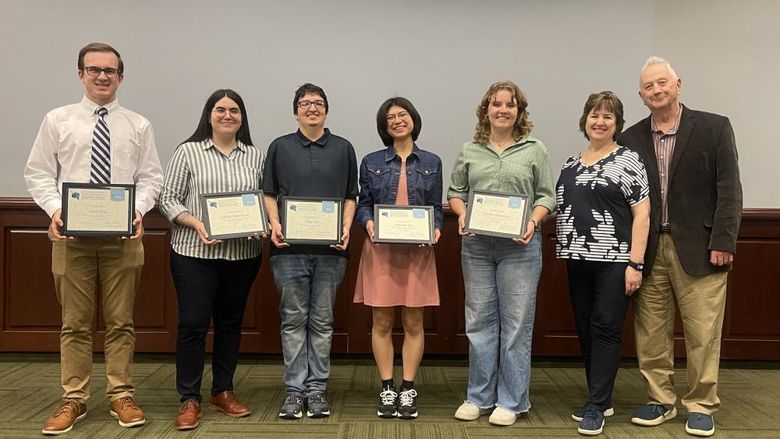
From left: Penn State Schuylkill students Mike Russell and Grace Muench, and Lee Silverberg, associate professor of chemistry.
SCHUYLKILL HAVEN, Pa. — Penn State Schuylkill students Grace Muench and Mike Russell presented their original organic chemistry research at the Middle Atlantic Regional Meeting (MARM) of the American Chemical Society in early June. Working with Lee Silverberg, associate professor of chemistry and STEM (science, technology, engineering and mathematics) division coordinator at Penn State Schuylkill, both students had abstracts accepted into the student portion of the conference program. Silverberg also spoke at the conference about the work issuing from his lab.
Research in Silverberg's organic chemistry lab is primarily focused on the study of heterocycles — a large and varied class of organic chemical compounds made up of atoms with at least two different elements joined together in a ring structure. Heterocyclic compounds can be used to develop novel drugs, pesticides, and other beneficial compounds. Silverberg’s group focuses on a class of compounds called 1,3-thiaza-4-ones, which have carbon, sulfur and nitrogen in the ring. Both student presentations and Silverberg’s discussion focused on various aspects of their ongoing research.
Fourth-year undergraduate student Mike Russell has been working with Silverberg since 2019, when he signed up for the honors option in Chemical Principles II. Chemistry research proved a perfect fit for Russell, and he quickly grew to enjoy time spent in the laboratory. Russell continued his honors option coursework through Organic Chemistry I and II, and Laboratory in Organic Chemistry. Even with all his chemistry coursework completed, Russell has continued working in the chemistry lab, independent of his regular classwork.
Using nuclear magnetic resonance analysis to test a hypothesis
Russell’s poster presentation detailed his research involving heterocyclic compounds, specifically the novel conversion of 1,3-thiaza-4-ones to dimeric thioacetals. Nuclear magnetic resonance (NMR) analysis, which is used to measure the quality and structure of the sample, unexpectedly showed conversion of the heterocycle to another compound. This required them to re-think their hypothesis and then analyze the resulting new compound. Russell’s work involved multiple controlled experiments under various conditions to recreate the predicted compound.
“I chose this topic because I thoroughly enjoyed problem-solving this issue that has been a troublesome question for us,” explained Russell. “Being able to explain the problems we faced with NMR analyses can aid future researchers who experience similar issues.”
While Russell and Silverberg have had success in recreating their proposed reaction with one type of 1,3-thiaza-4-ones, their goal is to repeat the experiment with additional compounds, which will then be subject to further NMR analysis.
A focus on sulfoxides
Third-year undergraduate student Grace Muench also completed her chemistry coursework as an honors option and like Russell will continue her research in organic chemistry outside of her assigned coursework.
Her work differs from Russell’s in that Muench has been more exclusively focused on sulfoxides — products that contain a double-bonded oxygen atom attached to the sulfur atom in the central ring of the organic compound. Her research is attempting to make sulfoxide reactions selective, and she is looking at the effects of variations in temperature on the reactions.
Muench explains her pursuit of sulfoxide research: “I use Oxone as an oxidant and a starting material made by either Dr. Silverberg or other students he has worked with in the past. Although there are a variety of experiments available in the organic chemistry lab, studying sulfoxides is where I first began. I am now fairly good with the sulfoxides, so I chose to focus my research on that topic.”
Excellence in undergraduate research
Russell and Muench each spent time in the lab after the spring semester ended, with additional research and refinement of their posters to prepare for their MARM presentations. In addition to lab techniques and problem-solving, students learn how to communicate their research in a professional setting, including the ability to answer questions related to their research, through the preparation involved in poster research conferences.
“Mike and Grace are both enthusiastic and talented student researchers,” stated Silverberg. “They are also both nice people who are a pleasure to work with. Dr. Mary Watson, who ran the student portion of the MARM conference, spoke with each of them during the conference and reported they both performed extremely well in presenting their research.”
Undergraduate research is a critical component of a Penn State Schuylkill education. Learn more about the opportunities for real-world research alongside faculty mentors representing disciplines as broad as the arts and humanities to STEM.





